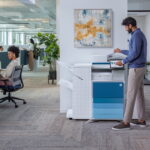
Apogee appoints new CEO to spearhead customer-first growth strategy in managed workplace services
5 February 2024
How businesses are meeting collaboration demands for employees, Gen X to Z
12 February 2024
The Importance of Making ‘Back to the Office’ Worthwhile
Mandating a return to the office isn’t an excuse to regress to pre-pandemic ways - especially if you aim to attract and retain valuable talent.
Just as the workforce has become used to the flexibility of hybrid work, it looks like the floorboards are ready to make another big shift from under them. Major players in the financial services industry – namely, JP Morgan, BlackRock, and Goldman Sachs – are returning to mandatory employee attendance at least four days a week.
While this does not necessarily spell the end for the era of remote work, it does show a desire for the collaborative energy that comes from employees sharing the same space – and their potential success could encourage other companies to follow suit.
However, returning to outdated pre-pandemic practices is sure to be met with resistance. Recent data from the Financial Services Skills Commission showed that 50% of employees want to continue to work on a flexible basis – and to make matters worse, carbon emissions generated from commutes and buildings energy will mean ESG objectives will likely suffer as a knock-on effect.

Therefore, if businesses are planning to reintroduce a return to a 4/5 on-site working week, serious consideration is required if they want to avoid alienating key talent. But how can they ensure offices are smart, sustainable, and, arguably the most important: worth the commute?
Crafting smart office spaces
Considering how much the workplace has transformed since 2020, it should go without saying that if businesses are planning for a mass return – especially those operating within financial services, where innovation is crucial – staff can’t be expected to return to outdated workplace environments. Seamless digital and print platforms, secure Cloud technologies, and streamlined document workflows all play their part toward employee efficiency, as well as providing ‘smart’ environments that top talent will be eager to engage with.
Obviously, achieving this will go beyond new aesthetics and a few ‘breakout’ spaces. A truly ‘smart’ office uses designs that welcome all kinds of work styles, and allow employees to move between collaborative sessions, focused work, and virtual meetings without trouble – matching the seamless, easy, and comfortable digital experiences they have created for themselves at home.

But this notion isn’t some far-off pipe dream. Many agile businesses are already reaping the benefits of increased employee connectivity - by using technology that streamlines typically frustrating processes like booking meeting rooms, in addition to sophisticated audio and video conferencing systems. In fact, recent research by Zippia found that improved capacity for communication and collaboration actually reduced employee turnover rates by up to 50%; as well as boosting productivity and engagement.
Putting people first
In our increasingly digitised world, it should be no surprise that there is now quite an overlap between quality of technology and quality of mental health. Our recent study revealed that nearly a third of employees sampled feel ‘isolated’ and ‘frustrated’ when insufficient collaboration technology damages their ability to perform their duties – a gap that can be bridged by building a stronger technology infrastructure.
Starting this process off on the right foot is crucial to a smooth transition back to the office – which is why it’s important to be transparent with your employees when explaining your reasons for doing so. Higher quality in-person interaction, skill development, and peer-to-peer collaboration are all strong benefits you can cite to quiet any concerns; and ensuring this will be supported by the latest tech may even rally support from your staff.

Keeping sustainability at the heart
If financial companies are going to initiate a return to the office, they have a responsibility to demonstrate the viability - and necessity – of adopting sustainable and responsible practices to other industries. If done correctly, this shift in industry practices could represent a valuable opportunity for ESG to become significantly more widespread.
This can only be beneficial for the future, especially since ESG is already shaping the business landscape of tomorrow. The construction industry, for example, must now follow strict ESG regulations when it comes to sales and purchase; and similarly, procurement processes for the public sector increasingly centre around vendors being able to demonstrate ‘social value’. Furthermore, ESG is also affecting recruitment opportunities – since 70% of employees now prioritise employers who show a visible commitment to sustainability. Clearly, returning to paper-heavy office environments is not an option.

But businesses don’t need to wait to start a drive for sustainability – the tools they need are all available right now. By leveraging energy efficient technologies, high quality refurbished devices that sustain the circular economy, and digital platforms that turn paper footprints into trees, companies can start aligning with their ESG goals right from their home turf – inspiring customer and employee in equal measure.
Shaping the next stage
Rather than an excuse to return to old habits, the potential opportunities created by ‘back to the office’ have amazing implications for the future of work. If done with the right tools, businesses will be on track to strike a balance between flexibility, sustainability, and innovation within their workplaces – and in doing so, ensure that the office is not only worth the commute, but somewhere that employees are eager to travel to from day-to-day.
For more of the latest business insights and news, check out our Insights page.
How We Can Help
To learn more, please fill out the contact form:
Latest insights
Keep up to date with all the latest in Managed Workplace Services.
By submitting this form, you acknowledge that you have read and understand the Apogee Privacy Statement.
Data Privacy Policy | Cookies Policy











































